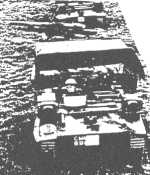The Gun - Mechanisation: Towed Field ArtilleryThe early 1920s saw the first serious attempts to mechanise horse and field artillery. They consisted merely of replacing the limber pole with an engine draught connector, then hooking gun and limber in to an ordinary commercial-type truck or tractor as was done with the mediums during World War 1. Some vehicles had FWD which enabled them to cope with bad roads but their bodies and suspensions were not sufficiently robust for heavy cross-country movement. Speed had to be kept down, especially on hard, rough roads, otherwise carriages (which had no springs) and the old wooden wheels of 4 feet 8 inch diameter (142 cm) suffered severely. To ease the strain, gun and limber wheels were sometimes fitted with solid rubber tyres but speed still had to be limited to 15 mph (24 kph). As a partial solution to the problem, some countries exchanged their wooden wheels for heavy steel types of varying diameters and styles, and fitted them with solid rubber tyres. Carriages so equipped could be towed somewhat faster but still suffered from shock and vibration. Obviously the answer was to fit pneumatic-tyred wheels. However, some objected to pneumatic tyres because they could easily be punctured by bullet or shell splinter, but this problem was solved by the introduction of 'run-flat' tyres which could be used for up to 50 miles while flat without further damage. In Britain the RA adopted pneumatic tyres for field gun carriages when mechanisation commenced. Portée MethodAs an alternative to towing the French initiated the 'portée' method by transporting their M1897 75-mm guns and limbers on the backs of flat-top trucks - a system employed by British Commonwealth anti-tank units during World War 2. Wear and tear on carriages and wheels were thus virtually eliminated but the inconvenience of loading and unloading them proved irksome, even with the ramps provided. The Germans went one better and fitted their truck with a winch to assist in loading and unloading the gun on to and off the flat-top. For cross-country movement small tractors were sometimes carried for use when the gun-carrying trucks ran out of road. The tractors were then unloaded and used to bring the guns into action. | |
 |
 |
| Mechanisation in the 1920s the French way. The Germans went one better and fitted their truck with a winch to assist in loading and unloading the gun on to and off the flat-top. | RA experiment during the late 1920s in trying to find an alternative to the dragon (below). The limber, which does not appear to be rubber tyred, must have had a hard time! |
The RA tried the portée method during the 1920s but soon gave it up. The RNZA also tried it a decade later but were likewise unimpressed. On more than one occasion was heard the remark, 'For Gawd's sake give us back the horses!' | |
 |
RNZA experiment in mechanisation circa 1937. The truck is a 1936 model Ford V8 with body lengthened for the purpose. |
DragonThe first RA unit was converted from horse to mechanical draught in 1923 with the adoption of the 'dragon' (coined from the words 'drag gun') as a gun tractor. It was a fully tracked vehicle designed to tow the 18-pr Mk 4 gun and limber and carry its detachment. Both gun and limber were fitted with pneumatic tyres. There were three marks of dragon: Mks 1 and 2 (with variations) were for field guns, while the heavier Mk 3 was intended for mediums. New Zealand Gunners were still making do with 18-prs Mk 1 and 2 until 1941. Other European countries generally favoured the half-track as a prime mover, made in various sizes to suit the equipments hauled, but some deployed wheeled tractors. | |
 |
Dragon Mk 2 introduced in 1933. The gun is the 18-pr Mk 4, later (in 1935) converted to 25-pr after which it became known as the 25-pr Mk 1 or the 18/25-pr. New Zealand Gunners were still making do with 18-prs Mk 1 and 2 until 1941. |
|
In Britain, as well as in most other countries, the changeover proceeded slowly during the 1920s and early 30s because little money was available for defence. Furthermore, the dragon was not proving an unqualified success. Although its cross-country performance fulfilled expectations it was slow; the Mk 1 could manage only 12 mph (19 kph). The Mk 2, first produced in 1933, was faster at 30 mph (48 kph). However, dragons were expensive, and long-distance road travel - to be expected in Europe - proved hard on tracks with unexpectedly steep repair bills. Consequently the RA continued to seek less expensive methods of moving its guns. During the late 1920s the RA experimented with a number of wheeled tractors - including some 4x4s - and even tried the French portée system. | |
 |
German half-track photographed during World War 2 towing their standard field gun, the 105-mm. Note special steel wheels with solid rubber tyres on gun. |
|
WL Ruffell, 1994 previous | index | next | History index | Home | |